Taxation Law: A Report on Tax Treatment of Accounting Items - Analysis
VerifiedAdded on 2023/06/05
|12
|2861
|456
Report
AI Summary
This report provides an analysis of the tax treatment of various accounting items for Technology Pty Ltd, referencing the ITAA 1997 and ITAA 1936. It discusses trading stock valuation, service revenue recognition, depreciation expenses, profits from the sale of machinery and land, and the deductibility of repair and maintenance expenditures. The report also addresses borrowing expenses, employee entertainment costs, provisions for holiday and long service leave, research expenses, and bad debt write-offs, offering interpretative explanations for each item's tax implications and referencing relevant case law and taxation rulings to support the analysis. The aim is to provide the CFO with a clear understanding of how these accounting items should be treated for tax purposes.
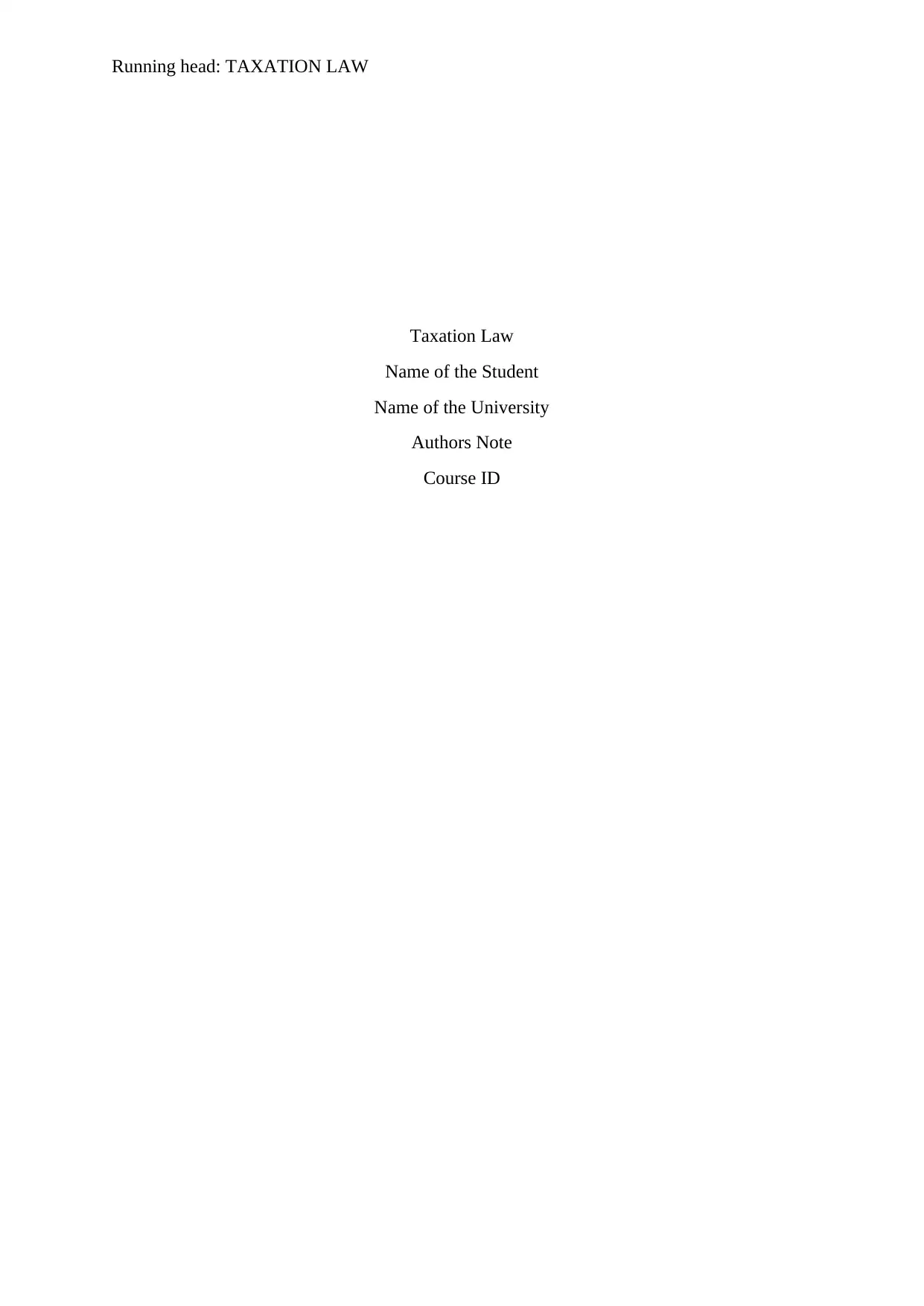
Running head: TAXATION LAW
Taxation Law
Name of the Student
Name of the University
Authors Note
Course ID
Taxation Law
Name of the Student
Name of the University
Authors Note
Course ID
Paraphrase This Document
Need a fresh take? Get an instant paraphrase of this document with our AI Paraphraser
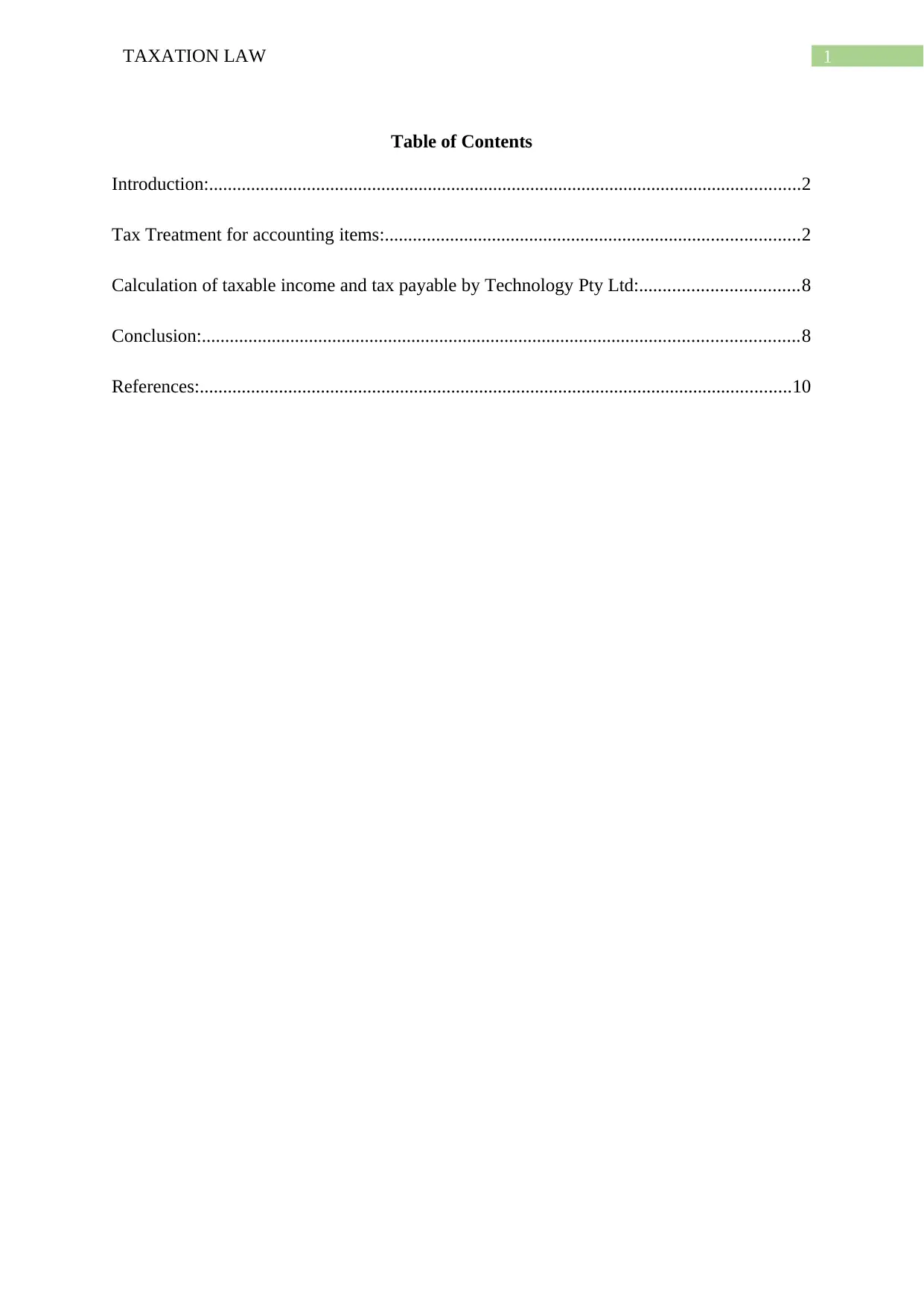
1TAXATION LAW
Table of Contents
Introduction:...............................................................................................................................2
Tax Treatment for accounting items:.........................................................................................2
Calculation of taxable income and tax payable by Technology Pty Ltd:..................................8
Conclusion:................................................................................................................................8
References:...............................................................................................................................10
Table of Contents
Introduction:...............................................................................................................................2
Tax Treatment for accounting items:.........................................................................................2
Calculation of taxable income and tax payable by Technology Pty Ltd:..................................8
Conclusion:................................................................................................................................8
References:...............................................................................................................................10
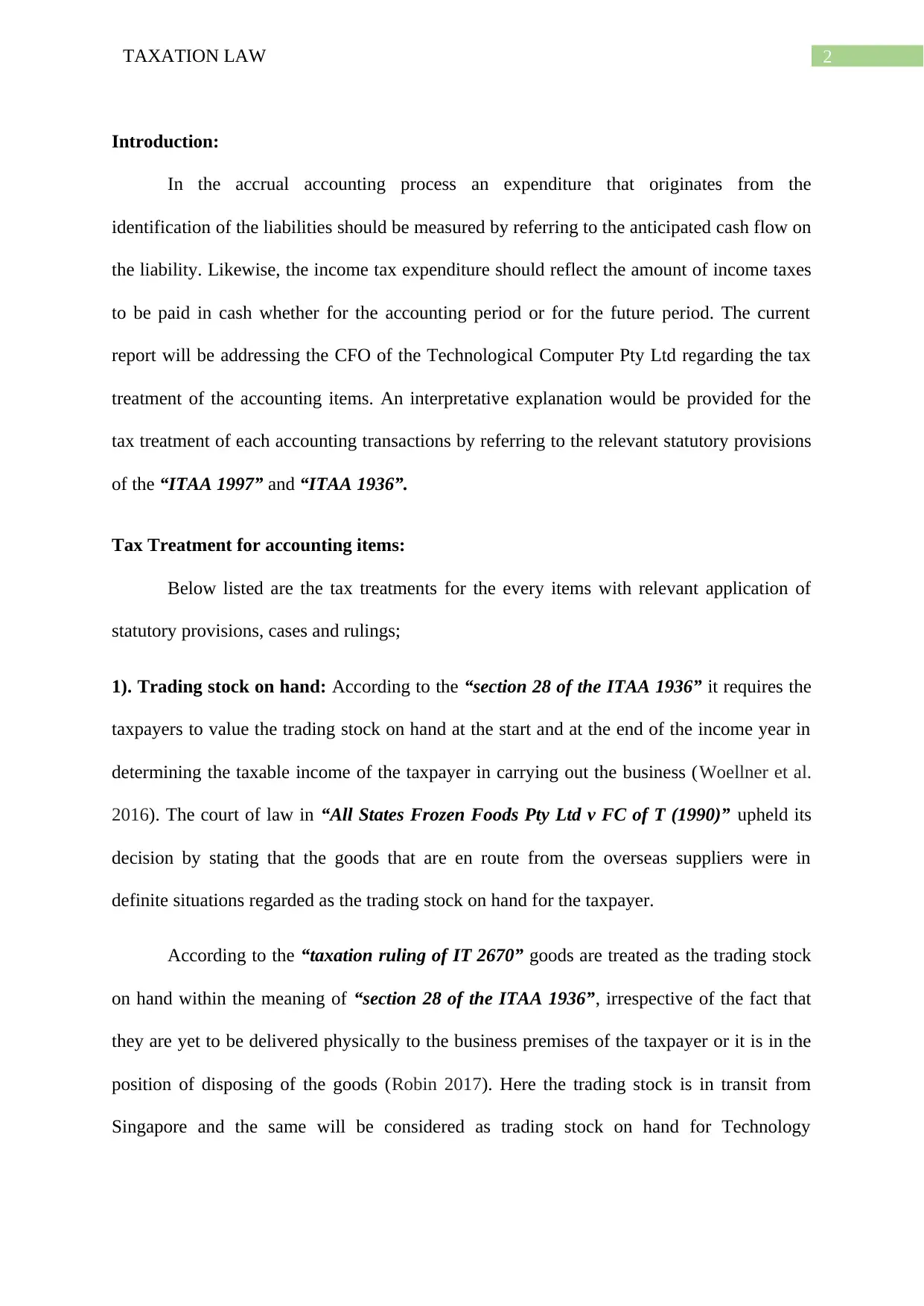
2TAXATION LAW
Introduction:
In the accrual accounting process an expenditure that originates from the
identification of the liabilities should be measured by referring to the anticipated cash flow on
the liability. Likewise, the income tax expenditure should reflect the amount of income taxes
to be paid in cash whether for the accounting period or for the future period. The current
report will be addressing the CFO of the Technological Computer Pty Ltd regarding the tax
treatment of the accounting items. An interpretative explanation would be provided for the
tax treatment of each accounting transactions by referring to the relevant statutory provisions
of the “ITAA 1997” and “ITAA 1936”.
Tax Treatment for accounting items:
Below listed are the tax treatments for the every items with relevant application of
statutory provisions, cases and rulings;
1). Trading stock on hand: According to the “section 28 of the ITAA 1936” it requires the
taxpayers to value the trading stock on hand at the start and at the end of the income year in
determining the taxable income of the taxpayer in carrying out the business (Woellner et al.
2016). The court of law in “All States Frozen Foods Pty Ltd v FC of T (1990)” upheld its
decision by stating that the goods that are en route from the overseas suppliers were in
definite situations regarded as the trading stock on hand for the taxpayer.
According to the “taxation ruling of IT 2670” goods are treated as the trading stock
on hand within the meaning of “section 28 of the ITAA 1936”, irrespective of the fact that
they are yet to be delivered physically to the business premises of the taxpayer or it is in the
position of disposing of the goods (Robin 2017). Here the trading stock is in transit from
Singapore and the same will be considered as trading stock on hand for Technology
Introduction:
In the accrual accounting process an expenditure that originates from the
identification of the liabilities should be measured by referring to the anticipated cash flow on
the liability. Likewise, the income tax expenditure should reflect the amount of income taxes
to be paid in cash whether for the accounting period or for the future period. The current
report will be addressing the CFO of the Technological Computer Pty Ltd regarding the tax
treatment of the accounting items. An interpretative explanation would be provided for the
tax treatment of each accounting transactions by referring to the relevant statutory provisions
of the “ITAA 1997” and “ITAA 1936”.
Tax Treatment for accounting items:
Below listed are the tax treatments for the every items with relevant application of
statutory provisions, cases and rulings;
1). Trading stock on hand: According to the “section 28 of the ITAA 1936” it requires the
taxpayers to value the trading stock on hand at the start and at the end of the income year in
determining the taxable income of the taxpayer in carrying out the business (Woellner et al.
2016). The court of law in “All States Frozen Foods Pty Ltd v FC of T (1990)” upheld its
decision by stating that the goods that are en route from the overseas suppliers were in
definite situations regarded as the trading stock on hand for the taxpayer.
According to the “taxation ruling of IT 2670” goods are treated as the trading stock
on hand within the meaning of “section 28 of the ITAA 1936”, irrespective of the fact that
they are yet to be delivered physically to the business premises of the taxpayer or it is in the
position of disposing of the goods (Robin 2017). Here the trading stock is in transit from
Singapore and the same will be considered as trading stock on hand for Technology
⊘ This is a preview!⊘
Do you want full access?
Subscribe today to unlock all pages.

Trusted by 1+ million students worldwide
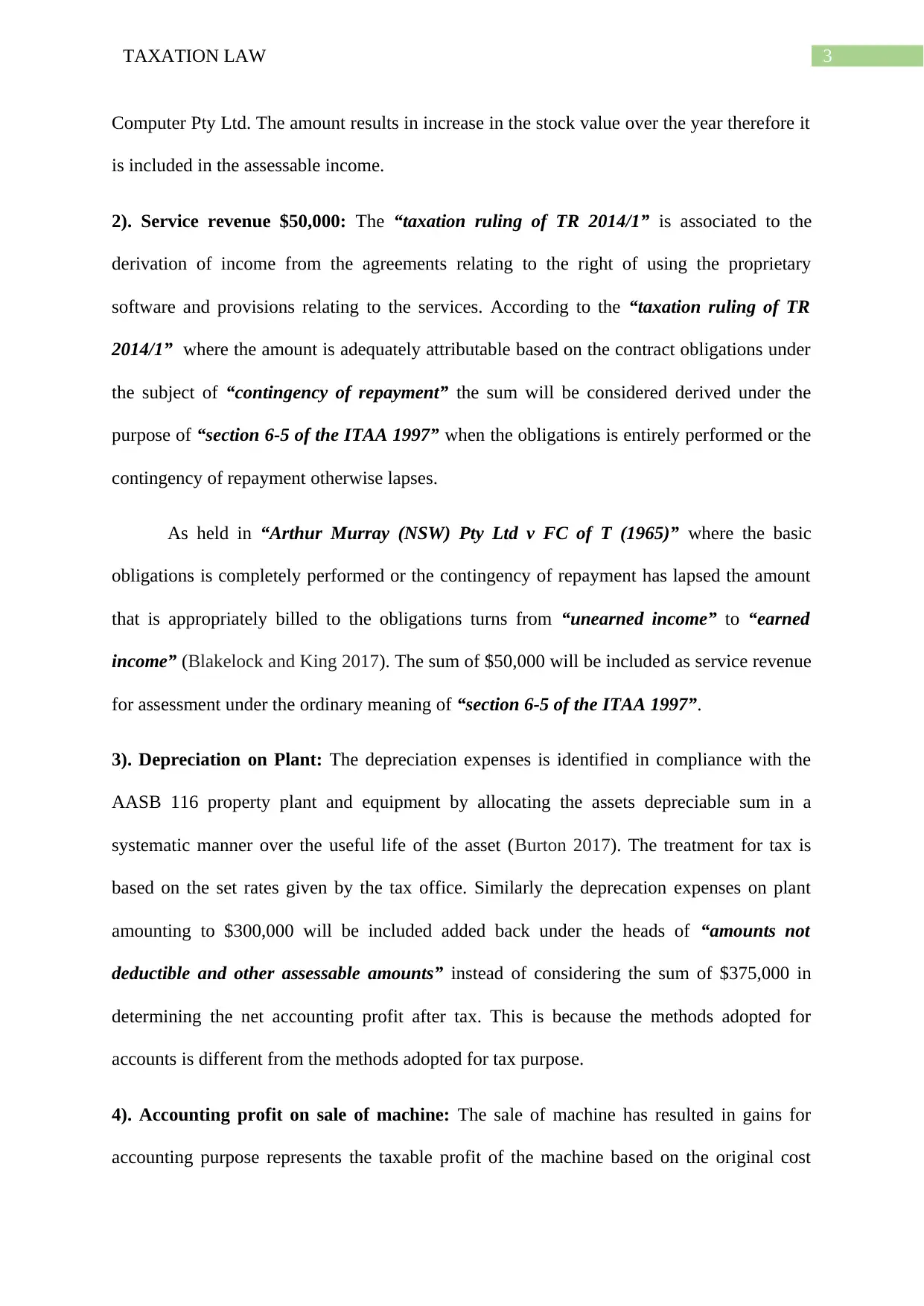
3TAXATION LAW
Computer Pty Ltd. The amount results in increase in the stock value over the year therefore it
is included in the assessable income.
2). Service revenue $50,000: The “taxation ruling of TR 2014/1” is associated to the
derivation of income from the agreements relating to the right of using the proprietary
software and provisions relating to the services. According to the “taxation ruling of TR
2014/1” where the amount is adequately attributable based on the contract obligations under
the subject of “contingency of repayment” the sum will be considered derived under the
purpose of “section 6-5 of the ITAA 1997” when the obligations is entirely performed or the
contingency of repayment otherwise lapses.
As held in “Arthur Murray (NSW) Pty Ltd v FC of T (1965)” where the basic
obligations is completely performed or the contingency of repayment has lapsed the amount
that is appropriately billed to the obligations turns from “unearned income” to “earned
income” (Blakelock and King 2017). The sum of $50,000 will be included as service revenue
for assessment under the ordinary meaning of “section 6-5 of the ITAA 1997”.
3). Depreciation on Plant: The depreciation expenses is identified in compliance with the
AASB 116 property plant and equipment by allocating the assets depreciable sum in a
systematic manner over the useful life of the asset (Burton 2017). The treatment for tax is
based on the set rates given by the tax office. Similarly the deprecation expenses on plant
amounting to $300,000 will be included added back under the heads of “amounts not
deductible and other assessable amounts” instead of considering the sum of $375,000 in
determining the net accounting profit after tax. This is because the methods adopted for
accounts is different from the methods adopted for tax purpose.
4). Accounting profit on sale of machine: The sale of machine has resulted in gains for
accounting purpose represents the taxable profit of the machine based on the original cost
Computer Pty Ltd. The amount results in increase in the stock value over the year therefore it
is included in the assessable income.
2). Service revenue $50,000: The “taxation ruling of TR 2014/1” is associated to the
derivation of income from the agreements relating to the right of using the proprietary
software and provisions relating to the services. According to the “taxation ruling of TR
2014/1” where the amount is adequately attributable based on the contract obligations under
the subject of “contingency of repayment” the sum will be considered derived under the
purpose of “section 6-5 of the ITAA 1997” when the obligations is entirely performed or the
contingency of repayment otherwise lapses.
As held in “Arthur Murray (NSW) Pty Ltd v FC of T (1965)” where the basic
obligations is completely performed or the contingency of repayment has lapsed the amount
that is appropriately billed to the obligations turns from “unearned income” to “earned
income” (Blakelock and King 2017). The sum of $50,000 will be included as service revenue
for assessment under the ordinary meaning of “section 6-5 of the ITAA 1997”.
3). Depreciation on Plant: The depreciation expenses is identified in compliance with the
AASB 116 property plant and equipment by allocating the assets depreciable sum in a
systematic manner over the useful life of the asset (Burton 2017). The treatment for tax is
based on the set rates given by the tax office. Similarly the deprecation expenses on plant
amounting to $300,000 will be included added back under the heads of “amounts not
deductible and other assessable amounts” instead of considering the sum of $375,000 in
determining the net accounting profit after tax. This is because the methods adopted for
accounts is different from the methods adopted for tax purpose.
4). Accounting profit on sale of machine: The sale of machine has resulted in gains for
accounting purpose represents the taxable profit of the machine based on the original cost
Paraphrase This Document
Need a fresh take? Get an instant paraphrase of this document with our AI Paraphraser
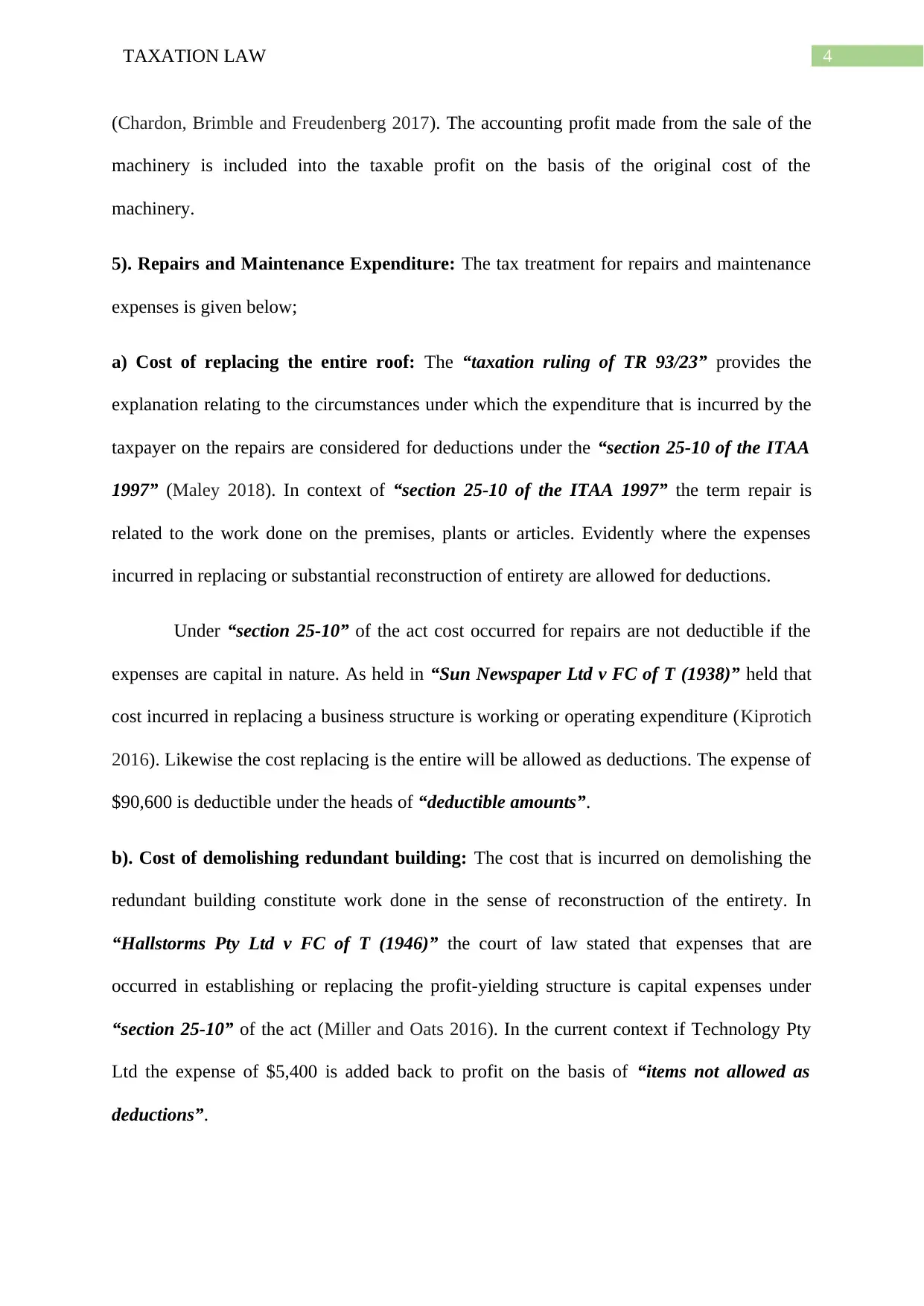
4TAXATION LAW
(Chardon, Brimble and Freudenberg 2017). The accounting profit made from the sale of the
machinery is included into the taxable profit on the basis of the original cost of the
machinery.
5). Repairs and Maintenance Expenditure: The tax treatment for repairs and maintenance
expenses is given below;
a) Cost of replacing the entire roof: The “taxation ruling of TR 93/23” provides the
explanation relating to the circumstances under which the expenditure that is incurred by the
taxpayer on the repairs are considered for deductions under the “section 25-10 of the ITAA
1997” (Maley 2018). In context of “section 25-10 of the ITAA 1997” the term repair is
related to the work done on the premises, plants or articles. Evidently where the expenses
incurred in replacing or substantial reconstruction of entirety are allowed for deductions.
Under “section 25-10” of the act cost occurred for repairs are not deductible if the
expenses are capital in nature. As held in “Sun Newspaper Ltd v FC of T (1938)” held that
cost incurred in replacing a business structure is working or operating expenditure (Kiprotich
2016). Likewise the cost replacing is the entire will be allowed as deductions. The expense of
$90,600 is deductible under the heads of “deductible amounts”.
b). Cost of demolishing redundant building: The cost that is incurred on demolishing the
redundant building constitute work done in the sense of reconstruction of the entirety. In
“Hallstorms Pty Ltd v FC of T (1946)” the court of law stated that expenses that are
occurred in establishing or replacing the profit-yielding structure is capital expenses under
“section 25-10” of the act (Miller and Oats 2016). In the current context if Technology Pty
Ltd the expense of $5,400 is added back to profit on the basis of “items not allowed as
deductions”.
(Chardon, Brimble and Freudenberg 2017). The accounting profit made from the sale of the
machinery is included into the taxable profit on the basis of the original cost of the
machinery.
5). Repairs and Maintenance Expenditure: The tax treatment for repairs and maintenance
expenses is given below;
a) Cost of replacing the entire roof: The “taxation ruling of TR 93/23” provides the
explanation relating to the circumstances under which the expenditure that is incurred by the
taxpayer on the repairs are considered for deductions under the “section 25-10 of the ITAA
1997” (Maley 2018). In context of “section 25-10 of the ITAA 1997” the term repair is
related to the work done on the premises, plants or articles. Evidently where the expenses
incurred in replacing or substantial reconstruction of entirety are allowed for deductions.
Under “section 25-10” of the act cost occurred for repairs are not deductible if the
expenses are capital in nature. As held in “Sun Newspaper Ltd v FC of T (1938)” held that
cost incurred in replacing a business structure is working or operating expenditure (Kiprotich
2016). Likewise the cost replacing is the entire will be allowed as deductions. The expense of
$90,600 is deductible under the heads of “deductible amounts”.
b). Cost of demolishing redundant building: The cost that is incurred on demolishing the
redundant building constitute work done in the sense of reconstruction of the entirety. In
“Hallstorms Pty Ltd v FC of T (1946)” the court of law stated that expenses that are
occurred in establishing or replacing the profit-yielding structure is capital expenses under
“section 25-10” of the act (Miller and Oats 2016). In the current context if Technology Pty
Ltd the expense of $5,400 is added back to profit on the basis of “items not allowed as
deductions”.
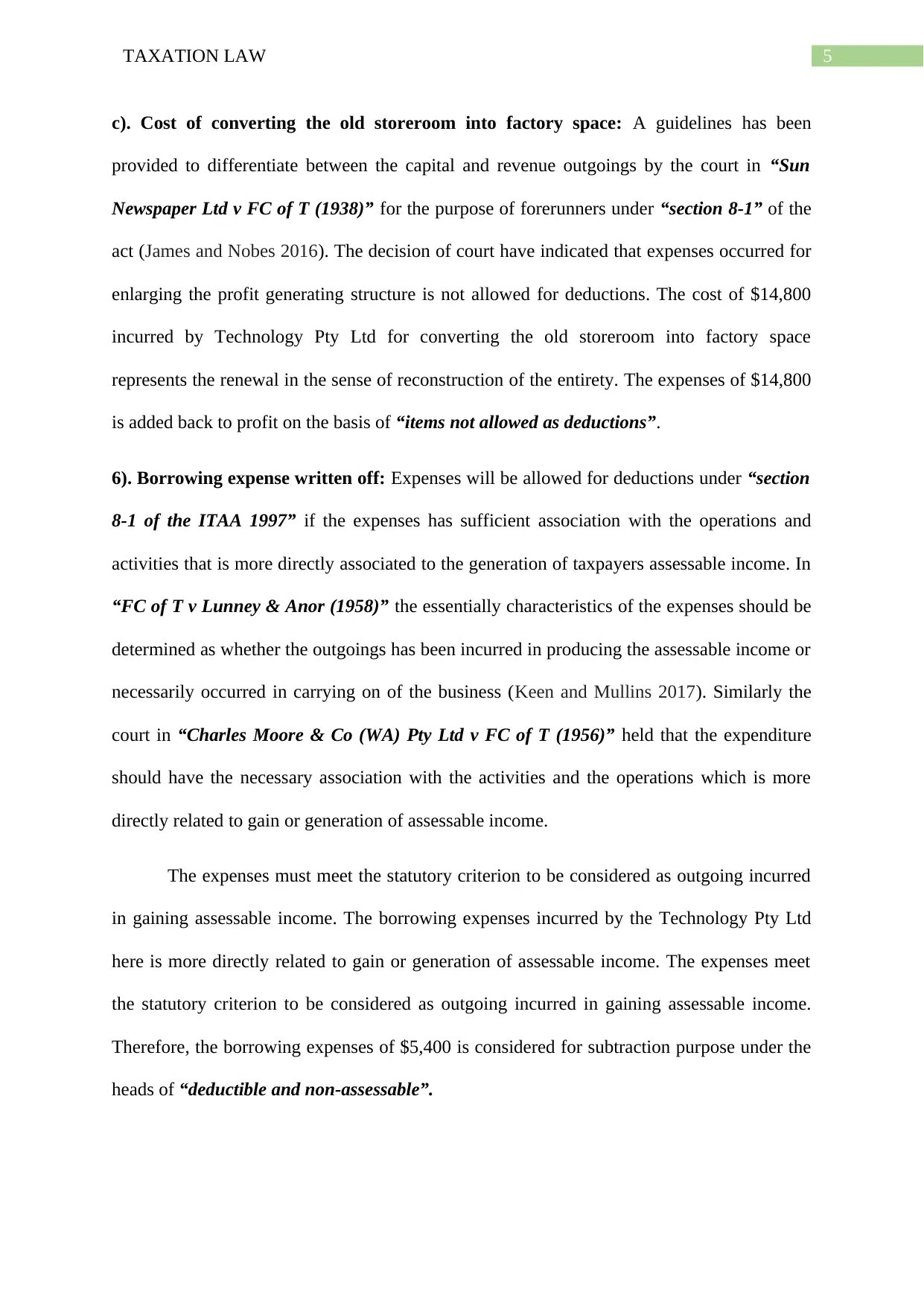
5TAXATION LAW
c). Cost of converting the old storeroom into factory space: A guidelines has been
provided to differentiate between the capital and revenue outgoings by the court in “Sun
Newspaper Ltd v FC of T (1938)” for the purpose of forerunners under “section 8-1” of the
act (James and Nobes 2016). The decision of court have indicated that expenses occurred for
enlarging the profit generating structure is not allowed for deductions. The cost of $14,800
incurred by Technology Pty Ltd for converting the old storeroom into factory space
represents the renewal in the sense of reconstruction of the entirety. The expenses of $14,800
is added back to profit on the basis of “items not allowed as deductions”.
6). Borrowing expense written off: Expenses will be allowed for deductions under “section
8-1 of the ITAA 1997” if the expenses has sufficient association with the operations and
activities that is more directly associated to the generation of taxpayers assessable income. In
“FC of T v Lunney & Anor (1958)” the essentially characteristics of the expenses should be
determined as whether the outgoings has been incurred in producing the assessable income or
necessarily occurred in carrying on of the business (Keen and Mullins 2017). Similarly the
court in “Charles Moore & Co (WA) Pty Ltd v FC of T (1956)” held that the expenditure
should have the necessary association with the activities and the operations which is more
directly related to gain or generation of assessable income.
The expenses must meet the statutory criterion to be considered as outgoing incurred
in gaining assessable income. The borrowing expenses incurred by the Technology Pty Ltd
here is more directly related to gain or generation of assessable income. The expenses meet
the statutory criterion to be considered as outgoing incurred in gaining assessable income.
Therefore, the borrowing expenses of $5,400 is considered for subtraction purpose under the
heads of “deductible and non-assessable”.
c). Cost of converting the old storeroom into factory space: A guidelines has been
provided to differentiate between the capital and revenue outgoings by the court in “Sun
Newspaper Ltd v FC of T (1938)” for the purpose of forerunners under “section 8-1” of the
act (James and Nobes 2016). The decision of court have indicated that expenses occurred for
enlarging the profit generating structure is not allowed for deductions. The cost of $14,800
incurred by Technology Pty Ltd for converting the old storeroom into factory space
represents the renewal in the sense of reconstruction of the entirety. The expenses of $14,800
is added back to profit on the basis of “items not allowed as deductions”.
6). Borrowing expense written off: Expenses will be allowed for deductions under “section
8-1 of the ITAA 1997” if the expenses has sufficient association with the operations and
activities that is more directly associated to the generation of taxpayers assessable income. In
“FC of T v Lunney & Anor (1958)” the essentially characteristics of the expenses should be
determined as whether the outgoings has been incurred in producing the assessable income or
necessarily occurred in carrying on of the business (Keen and Mullins 2017). Similarly the
court in “Charles Moore & Co (WA) Pty Ltd v FC of T (1956)” held that the expenditure
should have the necessary association with the activities and the operations which is more
directly related to gain or generation of assessable income.
The expenses must meet the statutory criterion to be considered as outgoing incurred
in gaining assessable income. The borrowing expenses incurred by the Technology Pty Ltd
here is more directly related to gain or generation of assessable income. The expenses meet
the statutory criterion to be considered as outgoing incurred in gaining assessable income.
Therefore, the borrowing expenses of $5,400 is considered for subtraction purpose under the
heads of “deductible and non-assessable”.
⊘ This is a preview!⊘
Do you want full access?
Subscribe today to unlock all pages.

Trusted by 1+ million students worldwide
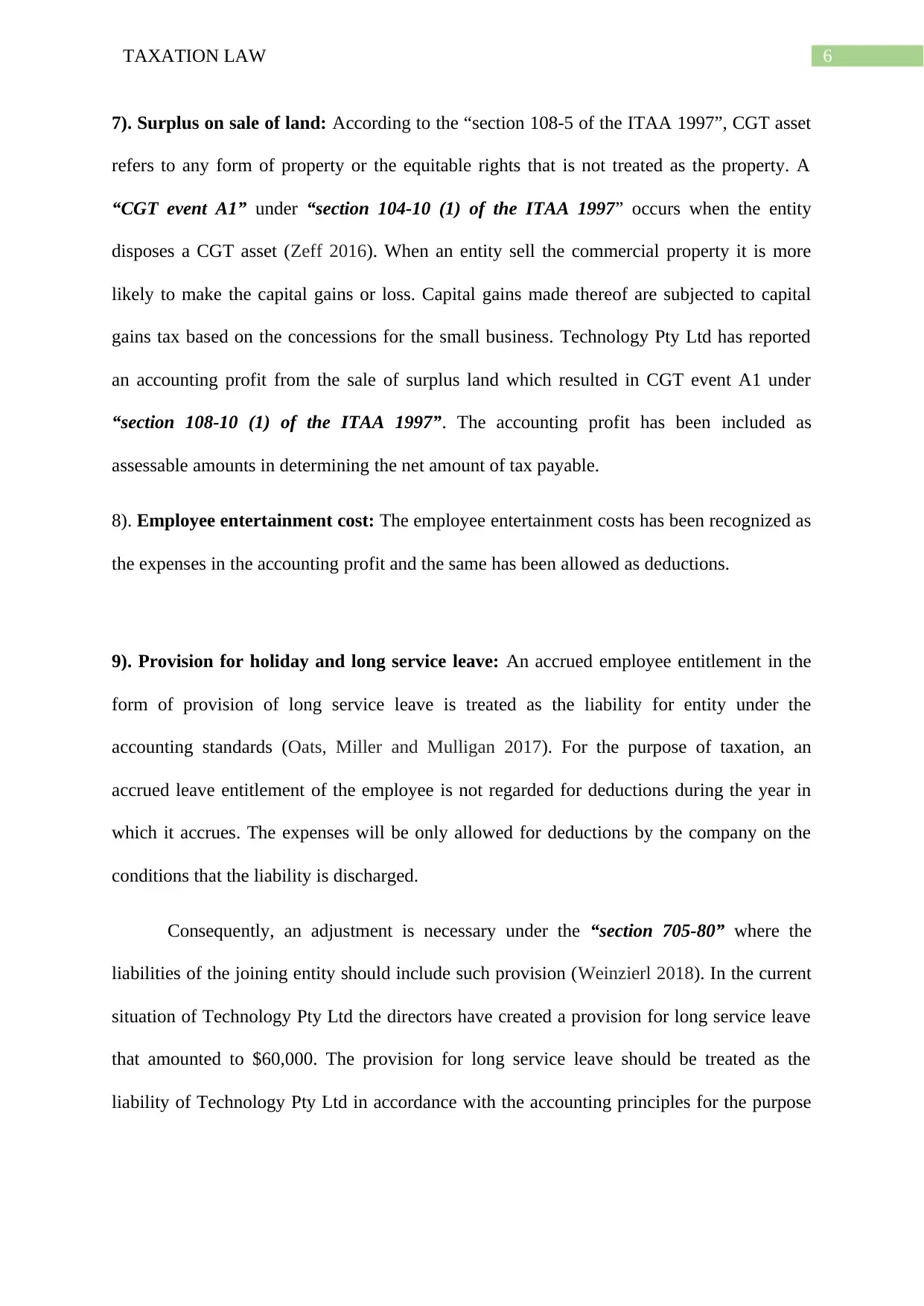
6TAXATION LAW
7). Surplus on sale of land: According to the “section 108-5 of the ITAA 1997”, CGT asset
refers to any form of property or the equitable rights that is not treated as the property. A
“CGT event A1” under “section 104-10 (1) of the ITAA 1997” occurs when the entity
disposes a CGT asset (Zeff 2016). When an entity sell the commercial property it is more
likely to make the capital gains or loss. Capital gains made thereof are subjected to capital
gains tax based on the concessions for the small business. Technology Pty Ltd has reported
an accounting profit from the sale of surplus land which resulted in CGT event A1 under
“section 108-10 (1) of the ITAA 1997”. The accounting profit has been included as
assessable amounts in determining the net amount of tax payable.
8). Employee entertainment cost: The employee entertainment costs has been recognized as
the expenses in the accounting profit and the same has been allowed as deductions.
9). Provision for holiday and long service leave: An accrued employee entitlement in the
form of provision of long service leave is treated as the liability for entity under the
accounting standards (Oats, Miller and Mulligan 2017). For the purpose of taxation, an
accrued leave entitlement of the employee is not regarded for deductions during the year in
which it accrues. The expenses will be only allowed for deductions by the company on the
conditions that the liability is discharged.
Consequently, an adjustment is necessary under the “section 705-80” where the
liabilities of the joining entity should include such provision (Weinzierl 2018). In the current
situation of Technology Pty Ltd the directors have created a provision for long service leave
that amounted to $60,000. The provision for long service leave should be treated as the
liability of Technology Pty Ltd in accordance with the accounting principles for the purpose
7). Surplus on sale of land: According to the “section 108-5 of the ITAA 1997”, CGT asset
refers to any form of property or the equitable rights that is not treated as the property. A
“CGT event A1” under “section 104-10 (1) of the ITAA 1997” occurs when the entity
disposes a CGT asset (Zeff 2016). When an entity sell the commercial property it is more
likely to make the capital gains or loss. Capital gains made thereof are subjected to capital
gains tax based on the concessions for the small business. Technology Pty Ltd has reported
an accounting profit from the sale of surplus land which resulted in CGT event A1 under
“section 108-10 (1) of the ITAA 1997”. The accounting profit has been included as
assessable amounts in determining the net amount of tax payable.
8). Employee entertainment cost: The employee entertainment costs has been recognized as
the expenses in the accounting profit and the same has been allowed as deductions.
9). Provision for holiday and long service leave: An accrued employee entitlement in the
form of provision of long service leave is treated as the liability for entity under the
accounting standards (Oats, Miller and Mulligan 2017). For the purpose of taxation, an
accrued leave entitlement of the employee is not regarded for deductions during the year in
which it accrues. The expenses will be only allowed for deductions by the company on the
conditions that the liability is discharged.
Consequently, an adjustment is necessary under the “section 705-80” where the
liabilities of the joining entity should include such provision (Weinzierl 2018). In the current
situation of Technology Pty Ltd the directors have created a provision for long service leave
that amounted to $60,000. The provision for long service leave should be treated as the
liability of Technology Pty Ltd in accordance with the accounting principles for the purpose
Paraphrase This Document
Need a fresh take? Get an instant paraphrase of this document with our AI Paraphraser
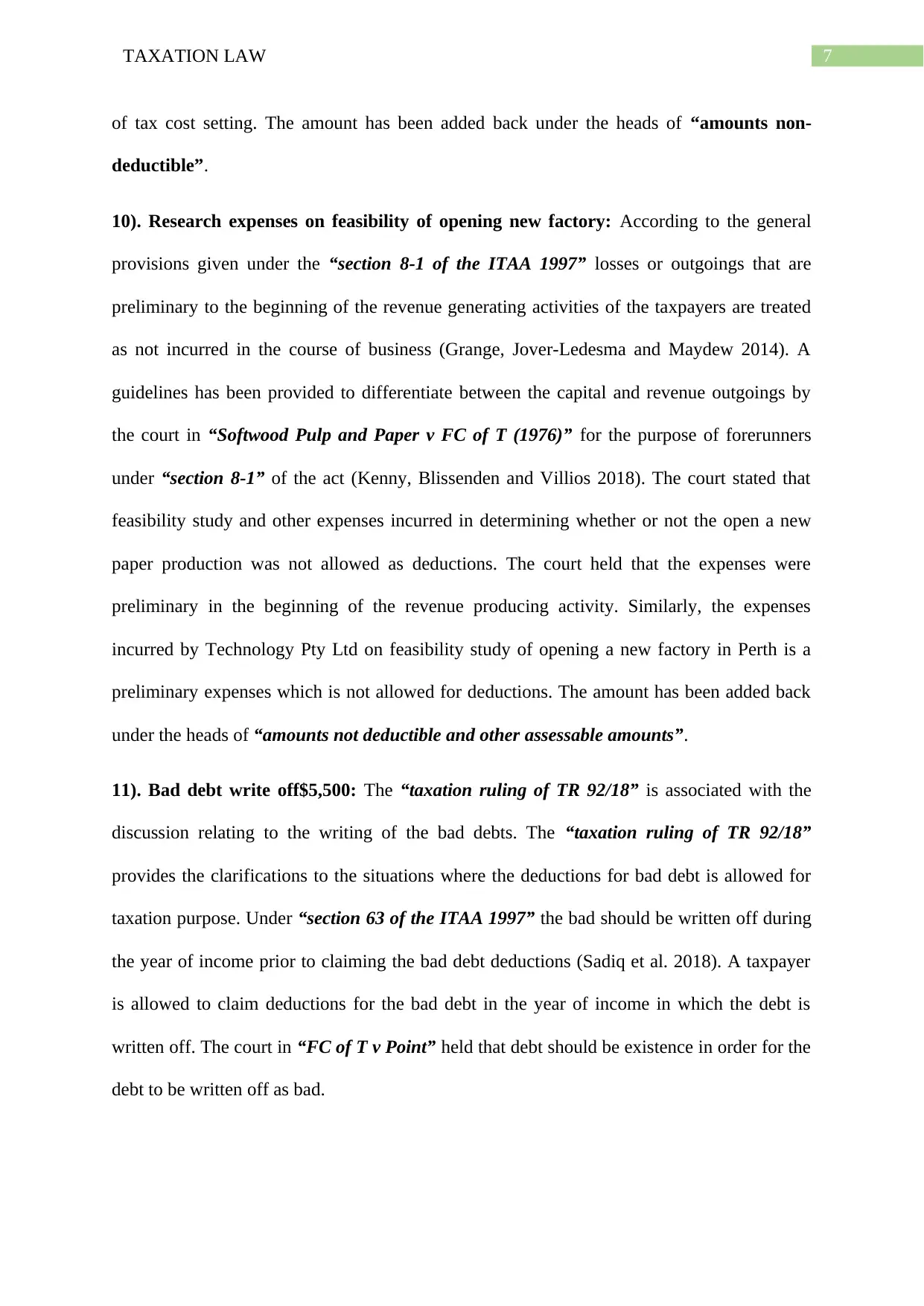
7TAXATION LAW
of tax cost setting. The amount has been added back under the heads of “amounts non-
deductible”.
10). Research expenses on feasibility of opening new factory: According to the general
provisions given under the “section 8-1 of the ITAA 1997” losses or outgoings that are
preliminary to the beginning of the revenue generating activities of the taxpayers are treated
as not incurred in the course of business (Grange, Jover-Ledesma and Maydew 2014). A
guidelines has been provided to differentiate between the capital and revenue outgoings by
the court in “Softwood Pulp and Paper v FC of T (1976)” for the purpose of forerunners
under “section 8-1” of the act (Kenny, Blissenden and Villios 2018). The court stated that
feasibility study and other expenses incurred in determining whether or not the open a new
paper production was not allowed as deductions. The court held that the expenses were
preliminary in the beginning of the revenue producing activity. Similarly, the expenses
incurred by Technology Pty Ltd on feasibility study of opening a new factory in Perth is a
preliminary expenses which is not allowed for deductions. The amount has been added back
under the heads of “amounts not deductible and other assessable amounts”.
11). Bad debt write off$5,500: The “taxation ruling of TR 92/18” is associated with the
discussion relating to the writing of the bad debts. The “taxation ruling of TR 92/18”
provides the clarifications to the situations where the deductions for bad debt is allowed for
taxation purpose. Under “section 63 of the ITAA 1997” the bad should be written off during
the year of income prior to claiming the bad debt deductions (Sadiq et al. 2018). A taxpayer
is allowed to claim deductions for the bad debt in the year of income in which the debt is
written off. The court in “FC of T v Point” held that debt should be existence in order for the
debt to be written off as bad.
of tax cost setting. The amount has been added back under the heads of “amounts non-
deductible”.
10). Research expenses on feasibility of opening new factory: According to the general
provisions given under the “section 8-1 of the ITAA 1997” losses or outgoings that are
preliminary to the beginning of the revenue generating activities of the taxpayers are treated
as not incurred in the course of business (Grange, Jover-Ledesma and Maydew 2014). A
guidelines has been provided to differentiate between the capital and revenue outgoings by
the court in “Softwood Pulp and Paper v FC of T (1976)” for the purpose of forerunners
under “section 8-1” of the act (Kenny, Blissenden and Villios 2018). The court stated that
feasibility study and other expenses incurred in determining whether or not the open a new
paper production was not allowed as deductions. The court held that the expenses were
preliminary in the beginning of the revenue producing activity. Similarly, the expenses
incurred by Technology Pty Ltd on feasibility study of opening a new factory in Perth is a
preliminary expenses which is not allowed for deductions. The amount has been added back
under the heads of “amounts not deductible and other assessable amounts”.
11). Bad debt write off$5,500: The “taxation ruling of TR 92/18” is associated with the
discussion relating to the writing of the bad debts. The “taxation ruling of TR 92/18”
provides the clarifications to the situations where the deductions for bad debt is allowed for
taxation purpose. Under “section 63 of the ITAA 1997” the bad should be written off during
the year of income prior to claiming the bad debt deductions (Sadiq et al. 2018). A taxpayer
is allowed to claim deductions for the bad debt in the year of income in which the debt is
written off. The court in “FC of T v Point” held that debt should be existence in order for the
debt to be written off as bad.
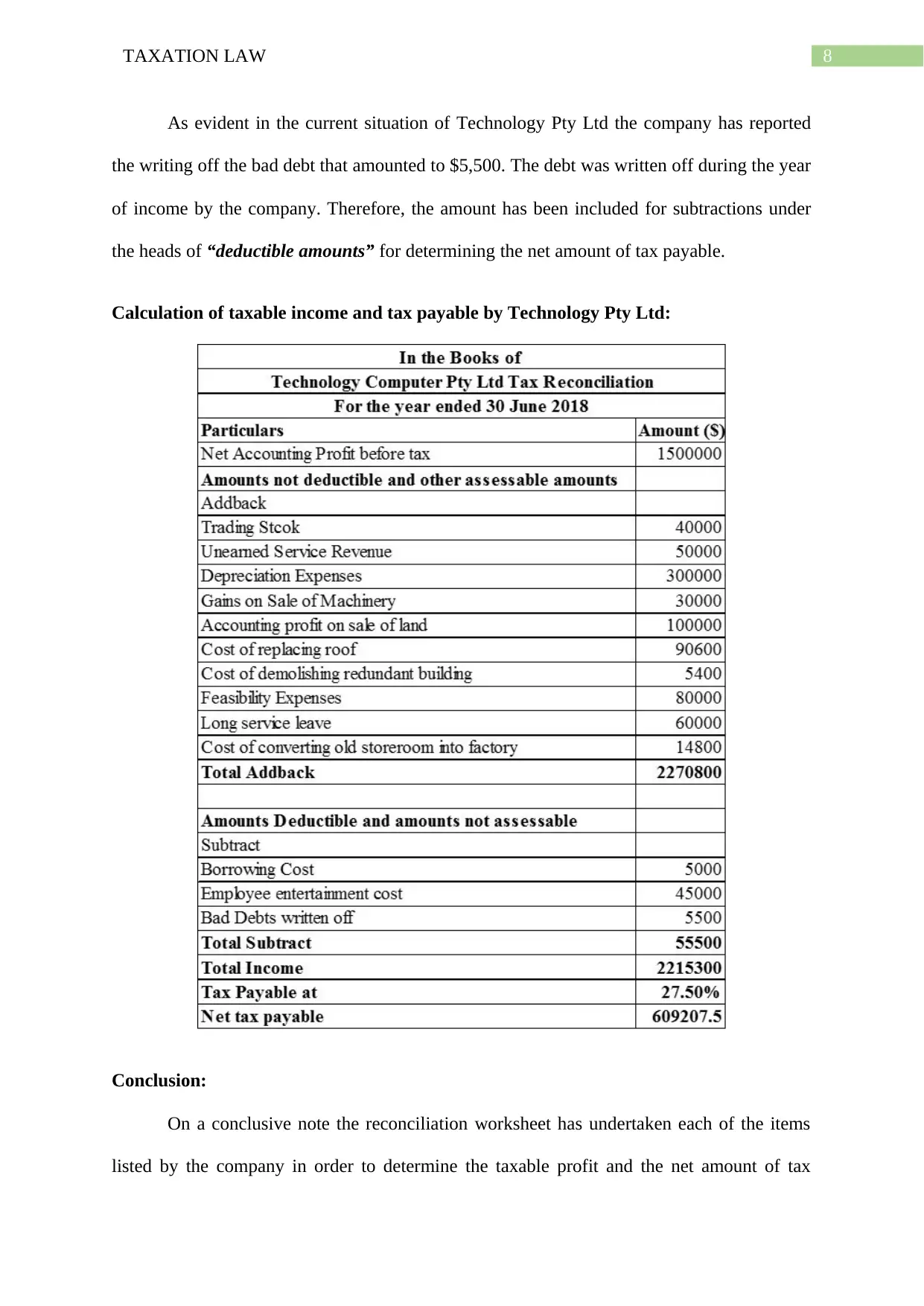
8TAXATION LAW
As evident in the current situation of Technology Pty Ltd the company has reported
the writing off the bad debt that amounted to $5,500. The debt was written off during the year
of income by the company. Therefore, the amount has been included for subtractions under
the heads of “deductible amounts” for determining the net amount of tax payable.
Calculation of taxable income and tax payable by Technology Pty Ltd:
Conclusion:
On a conclusive note the reconciliation worksheet has undertaken each of the items
listed by the company in order to determine the taxable profit and the net amount of tax
As evident in the current situation of Technology Pty Ltd the company has reported
the writing off the bad debt that amounted to $5,500. The debt was written off during the year
of income by the company. Therefore, the amount has been included for subtractions under
the heads of “deductible amounts” for determining the net amount of tax payable.
Calculation of taxable income and tax payable by Technology Pty Ltd:
Conclusion:
On a conclusive note the reconciliation worksheet has undertaken each of the items
listed by the company in order to determine the taxable profit and the net amount of tax
⊘ This is a preview!⊘
Do you want full access?
Subscribe today to unlock all pages.

Trusted by 1+ million students worldwide
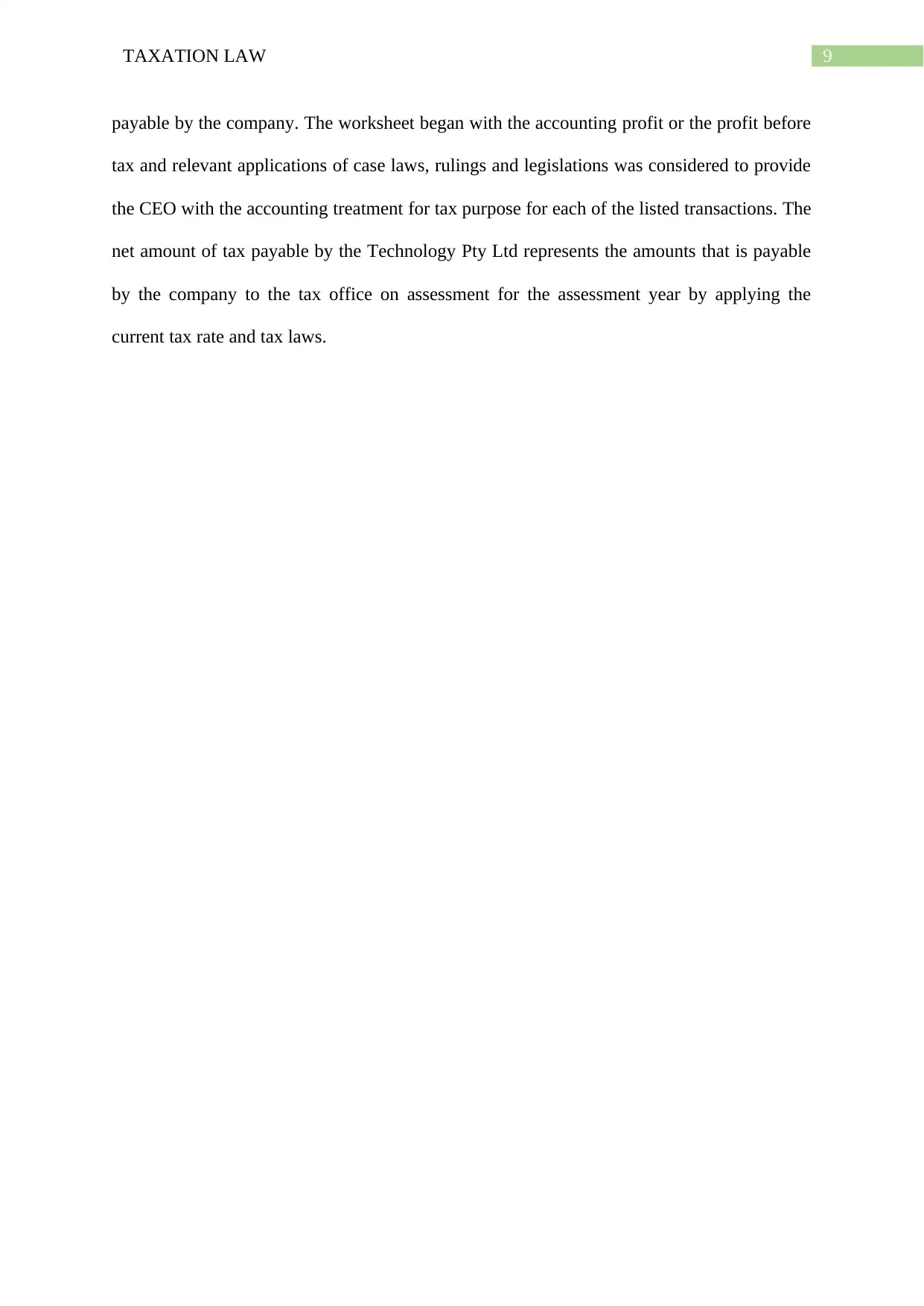
9TAXATION LAW
payable by the company. The worksheet began with the accounting profit or the profit before
tax and relevant applications of case laws, rulings and legislations was considered to provide
the CEO with the accounting treatment for tax purpose for each of the listed transactions. The
net amount of tax payable by the Technology Pty Ltd represents the amounts that is payable
by the company to the tax office on assessment for the assessment year by applying the
current tax rate and tax laws.
payable by the company. The worksheet began with the accounting profit or the profit before
tax and relevant applications of case laws, rulings and legislations was considered to provide
the CEO with the accounting treatment for tax purpose for each of the listed transactions. The
net amount of tax payable by the Technology Pty Ltd represents the amounts that is payable
by the company to the tax office on assessment for the assessment year by applying the
current tax rate and tax laws.
Paraphrase This Document
Need a fresh take? Get an instant paraphrase of this document with our AI Paraphraser
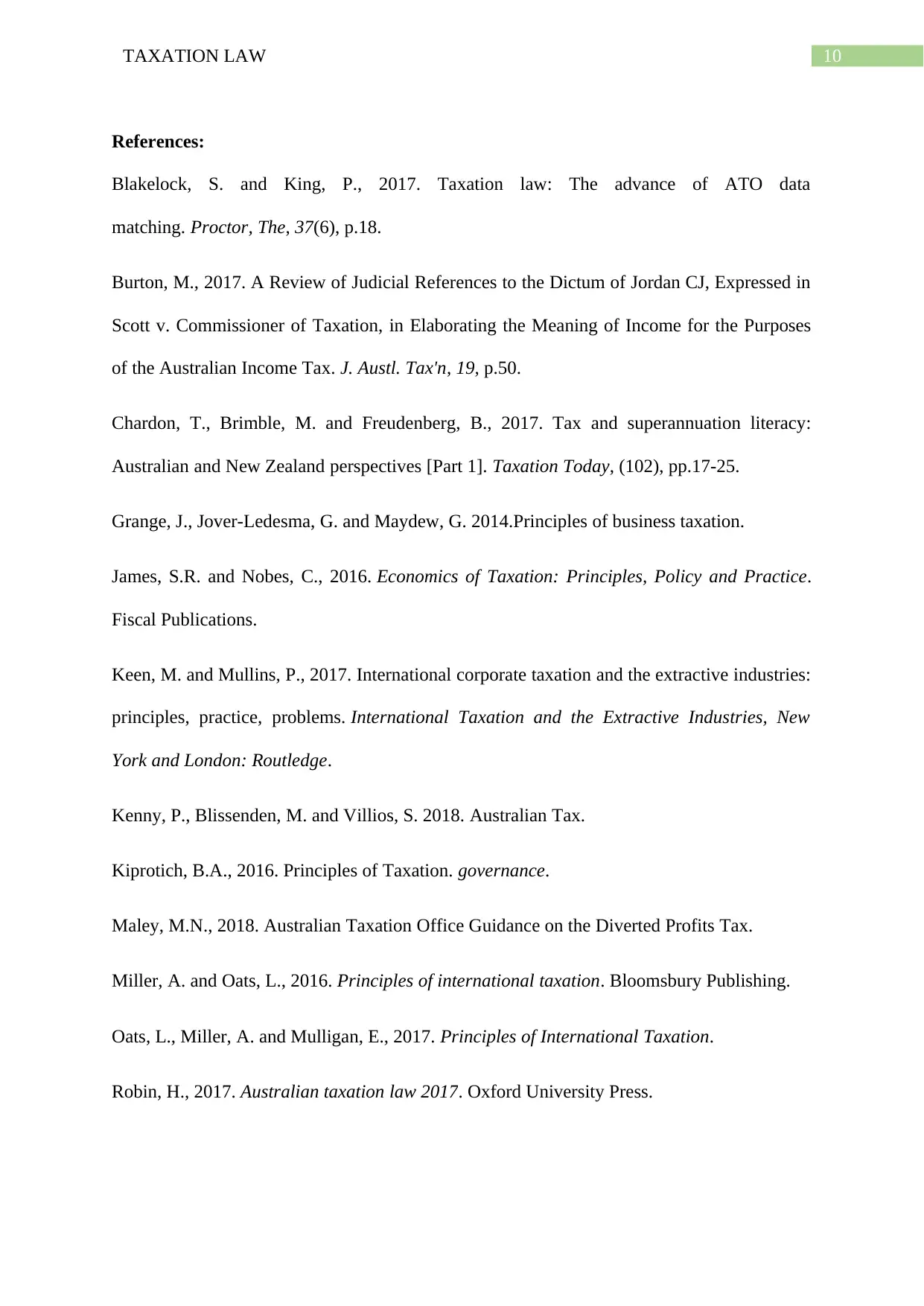
10TAXATION LAW
References:
Blakelock, S. and King, P., 2017. Taxation law: The advance of ATO data
matching. Proctor, The, 37(6), p.18.
Burton, M., 2017. A Review of Judicial References to the Dictum of Jordan CJ, Expressed in
Scott v. Commissioner of Taxation, in Elaborating the Meaning of Income for the Purposes
of the Australian Income Tax. J. Austl. Tax'n, 19, p.50.
Chardon, T., Brimble, M. and Freudenberg, B., 2017. Tax and superannuation literacy:
Australian and New Zealand perspectives [Part 1]. Taxation Today, (102), pp.17-25.
Grange, J., Jover-Ledesma, G. and Maydew, G. 2014.Principles of business taxation.
James, S.R. and Nobes, C., 2016. Economics of Taxation: Principles, Policy and Practice.
Fiscal Publications.
Keen, M. and Mullins, P., 2017. International corporate taxation and the extractive industries:
principles, practice, problems. International Taxation and the Extractive Industries, New
York and London: Routledge.
Kenny, P., Blissenden, M. and Villios, S. 2018. Australian Tax.
Kiprotich, B.A., 2016. Principles of Taxation. governance.
Maley, M.N., 2018. Australian Taxation Office Guidance on the Diverted Profits Tax.
Miller, A. and Oats, L., 2016. Principles of international taxation. Bloomsbury Publishing.
Oats, L., Miller, A. and Mulligan, E., 2017. Principles of International Taxation.
Robin, H., 2017. Australian taxation law 2017. Oxford University Press.
References:
Blakelock, S. and King, P., 2017. Taxation law: The advance of ATO data
matching. Proctor, The, 37(6), p.18.
Burton, M., 2017. A Review of Judicial References to the Dictum of Jordan CJ, Expressed in
Scott v. Commissioner of Taxation, in Elaborating the Meaning of Income for the Purposes
of the Australian Income Tax. J. Austl. Tax'n, 19, p.50.
Chardon, T., Brimble, M. and Freudenberg, B., 2017. Tax and superannuation literacy:
Australian and New Zealand perspectives [Part 1]. Taxation Today, (102), pp.17-25.
Grange, J., Jover-Ledesma, G. and Maydew, G. 2014.Principles of business taxation.
James, S.R. and Nobes, C., 2016. Economics of Taxation: Principles, Policy and Practice.
Fiscal Publications.
Keen, M. and Mullins, P., 2017. International corporate taxation and the extractive industries:
principles, practice, problems. International Taxation and the Extractive Industries, New
York and London: Routledge.
Kenny, P., Blissenden, M. and Villios, S. 2018. Australian Tax.
Kiprotich, B.A., 2016. Principles of Taxation. governance.
Maley, M.N., 2018. Australian Taxation Office Guidance on the Diverted Profits Tax.
Miller, A. and Oats, L., 2016. Principles of international taxation. Bloomsbury Publishing.
Oats, L., Miller, A. and Mulligan, E., 2017. Principles of International Taxation.
Robin, H., 2017. Australian taxation law 2017. Oxford University Press.
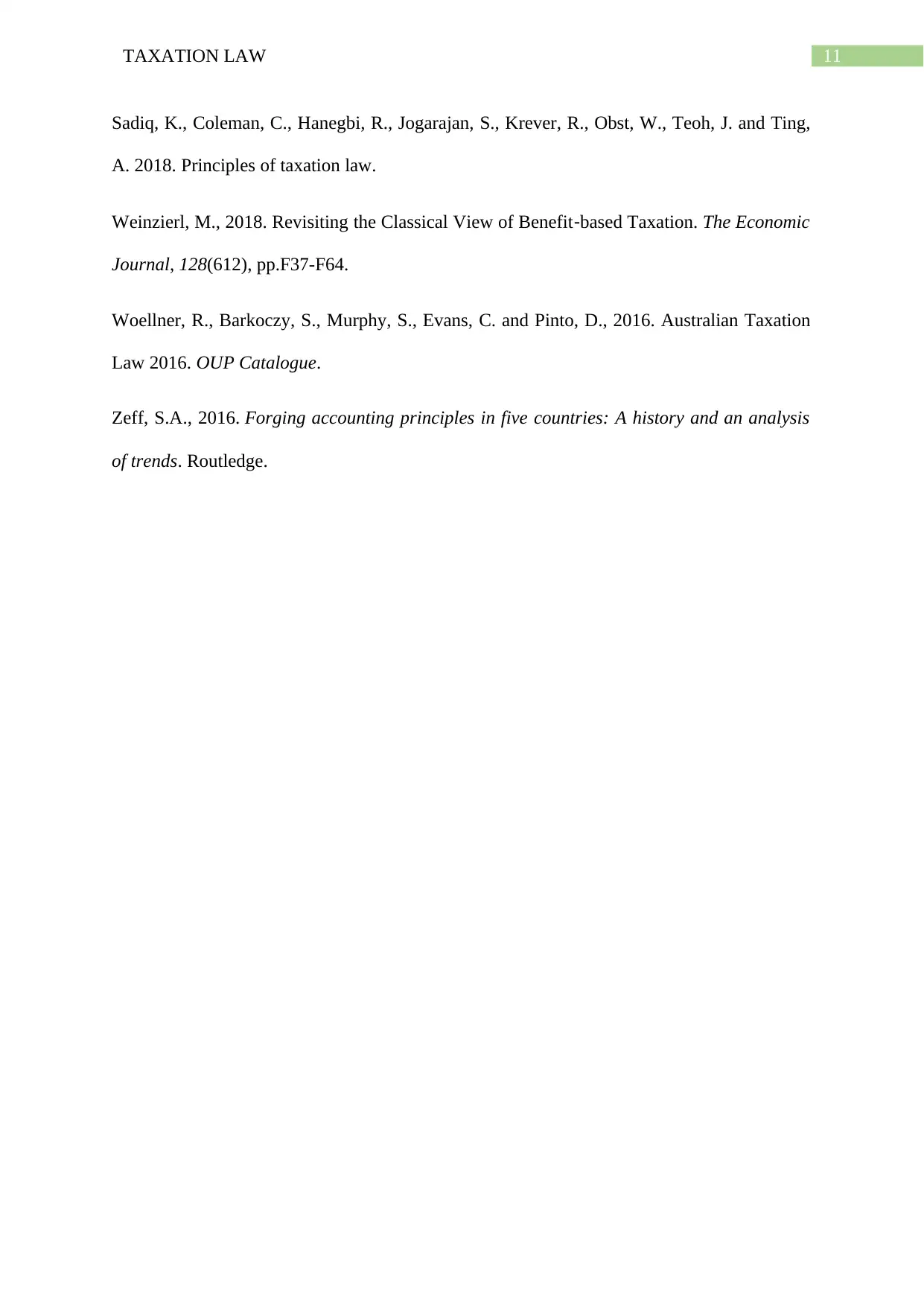
11TAXATION LAW
Sadiq, K., Coleman, C., Hanegbi, R., Jogarajan, S., Krever, R., Obst, W., Teoh, J. and Ting,
A. 2018. Principles of taxation law.
Weinzierl, M., 2018. Revisiting the Classical View of Benefit‐based Taxation. The Economic
Journal, 128(612), pp.F37-F64.
Woellner, R., Barkoczy, S., Murphy, S., Evans, C. and Pinto, D., 2016. Australian Taxation
Law 2016. OUP Catalogue.
Zeff, S.A., 2016. Forging accounting principles in five countries: A history and an analysis
of trends. Routledge.
Sadiq, K., Coleman, C., Hanegbi, R., Jogarajan, S., Krever, R., Obst, W., Teoh, J. and Ting,
A. 2018. Principles of taxation law.
Weinzierl, M., 2018. Revisiting the Classical View of Benefit‐based Taxation. The Economic
Journal, 128(612), pp.F37-F64.
Woellner, R., Barkoczy, S., Murphy, S., Evans, C. and Pinto, D., 2016. Australian Taxation
Law 2016. OUP Catalogue.
Zeff, S.A., 2016. Forging accounting principles in five countries: A history and an analysis
of trends. Routledge.
⊘ This is a preview!⊘
Do you want full access?
Subscribe today to unlock all pages.

Trusted by 1+ million students worldwide
1 out of 12
Related Documents
Your All-in-One AI-Powered Toolkit for Academic Success.
+13062052269
info@desklib.com
Available 24*7 on WhatsApp / Email
![[object Object]](/_next/static/media/star-bottom.7253800d.svg)
Unlock your academic potential
Copyright © 2020–2025 A2Z Services. All Rights Reserved. Developed and managed by ZUCOL.





